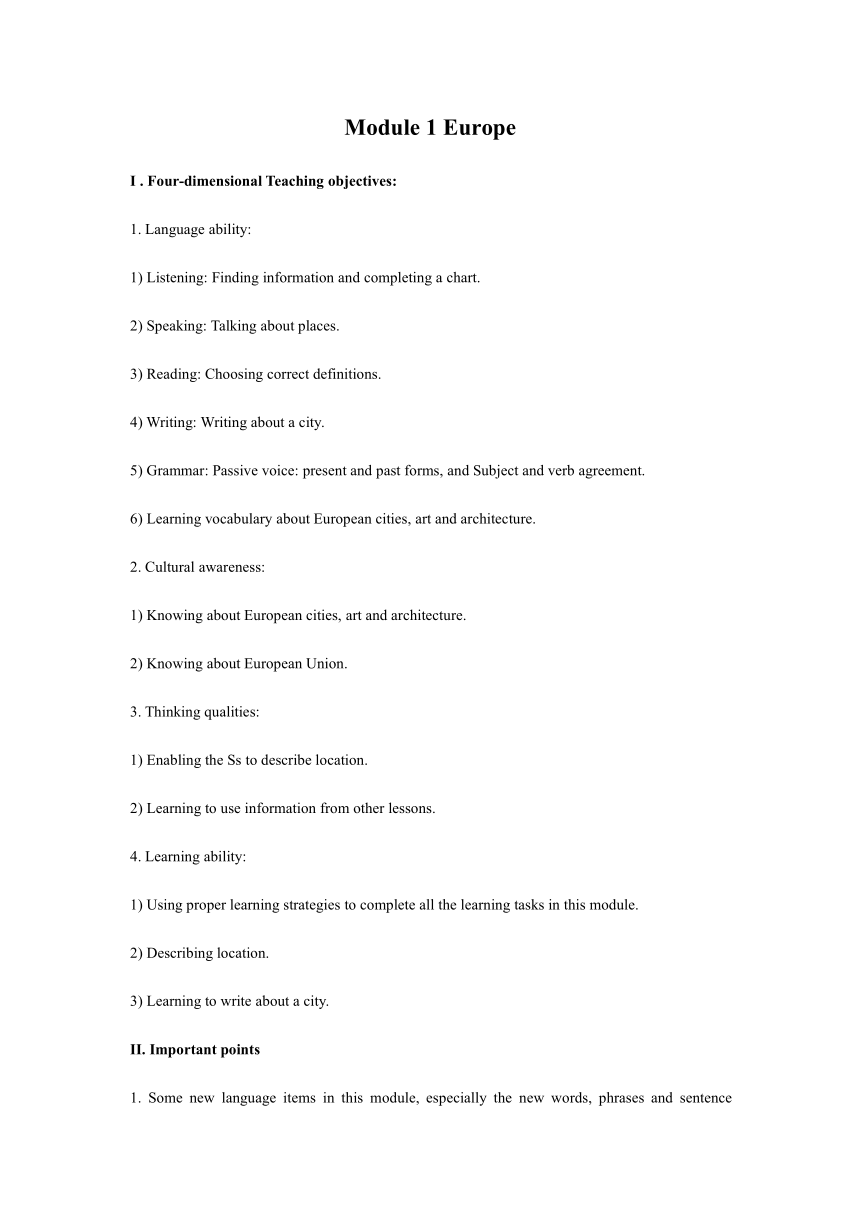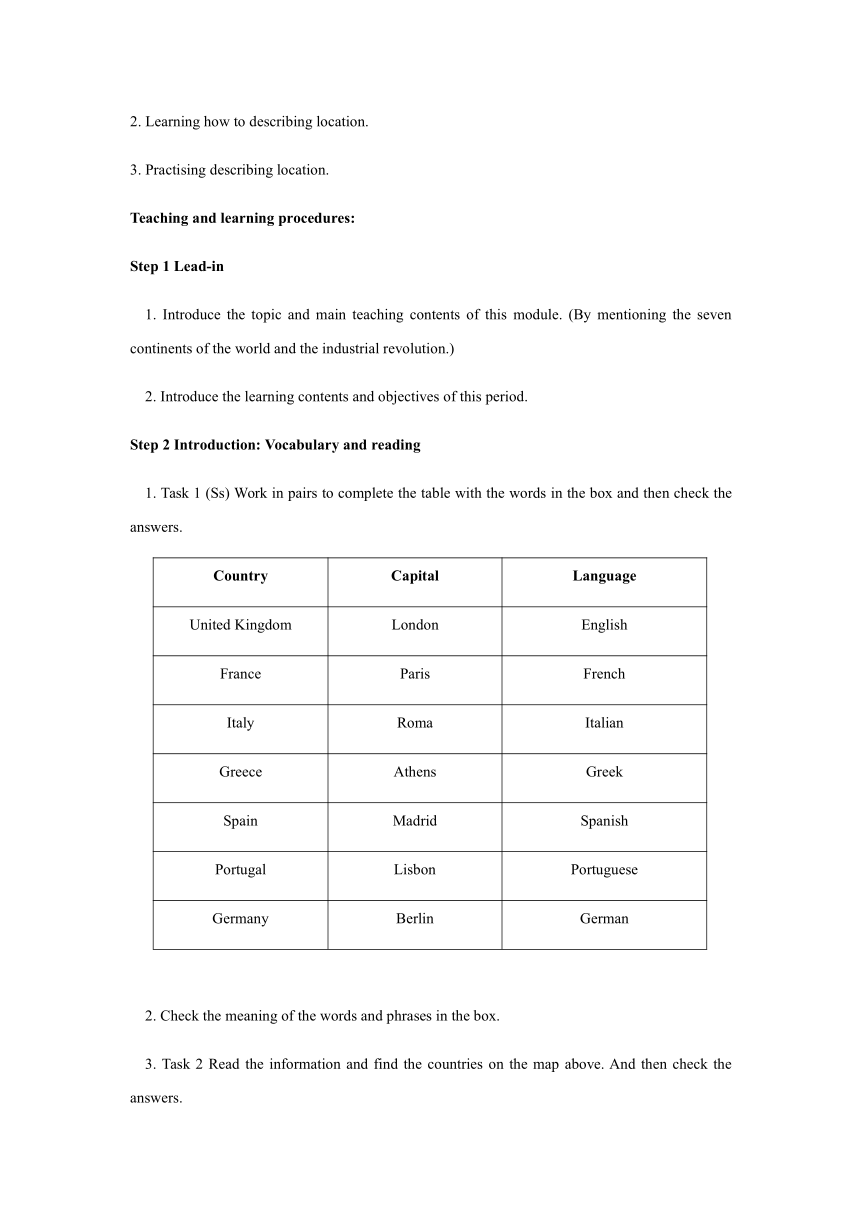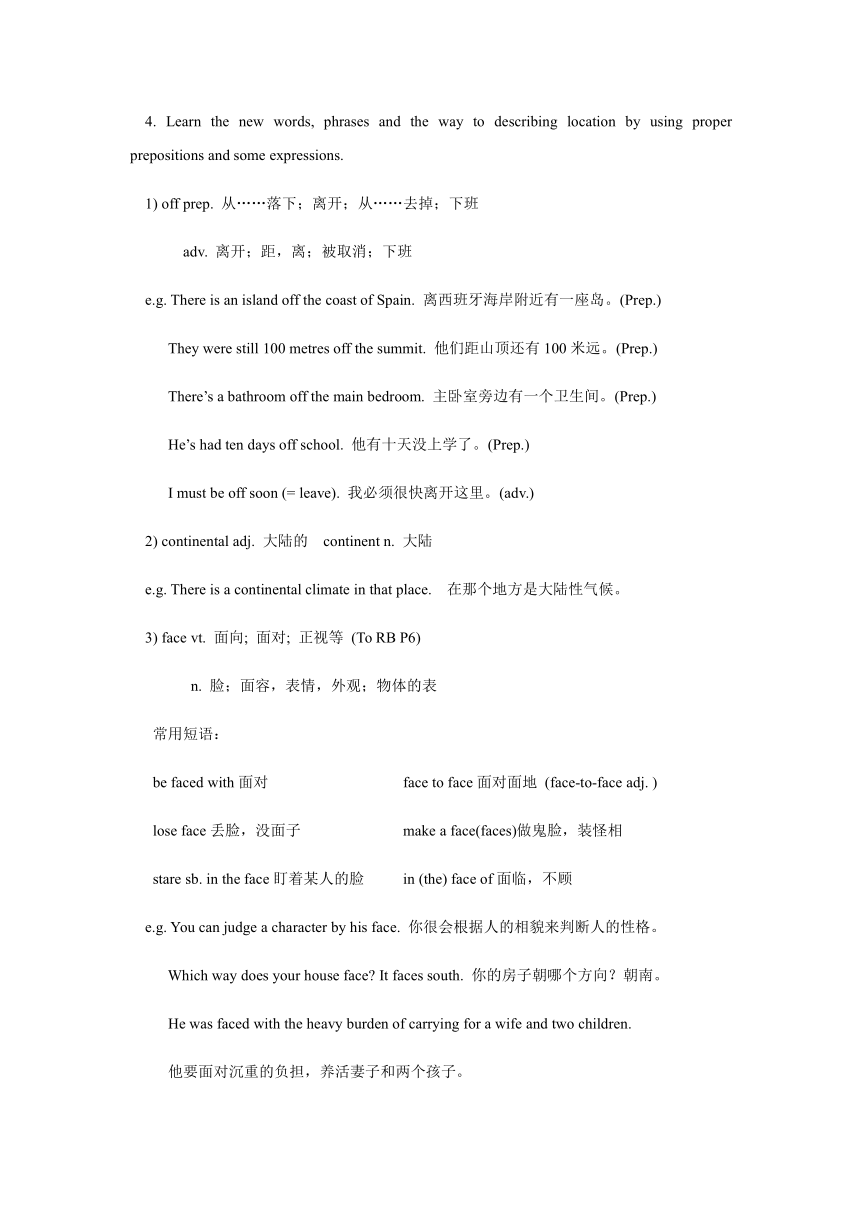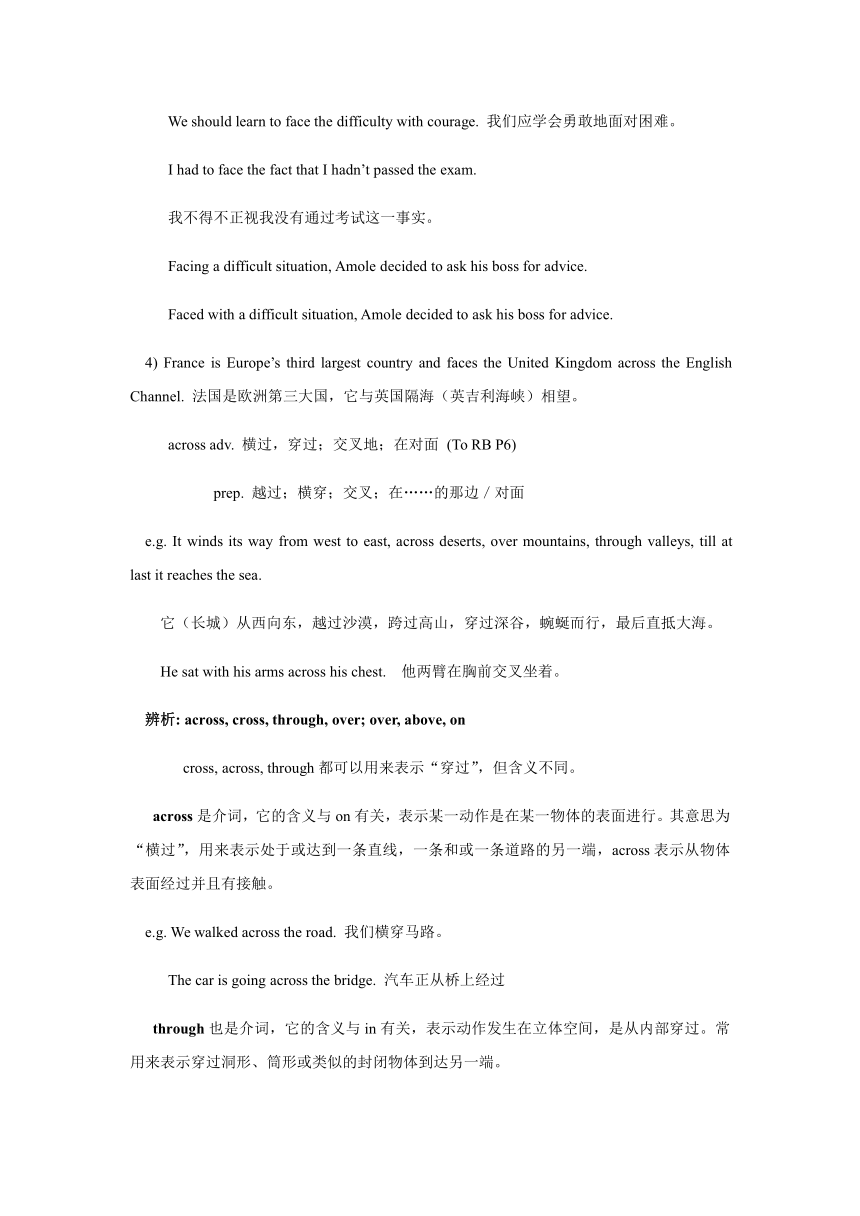高一英语精品同步课堂外研版必修3 Module 1 Europe Period 1(教案)
文档属性
| 名称 | 高一英语精品同步课堂外研版必修3 Module 1 Europe Period 1(教案) |

|
|
| 格式 | zip | ||
| 文件大小 | 206.5KB | ||
| 资源类型 | 教案 | ||
| 版本资源 | 外研版 | ||
| 科目 | 英语 | ||
| 更新时间 | 2019-12-15 08:21:53 | ||
图片预览





文档简介
Module 1 Europe
I . Four-dimensional Teaching objectives:
1. Language ability:
1) Listening: Finding information and completing a chart.
2) Speaking: Talking about places.
3) Reading: Choosing correct definitions.
4) Writing: Writing about a city.
5) Grammar: Passive voice: present and past forms, and Subject and verb agreement.
6) Learning vocabulary about European cities, art and architecture.
2. Cultural awareness:
1) Knowing about European cities, art and architecture.
2) Knowing about European Union.
3. Thinking qualities:
1) Enabling the Ss to describe location.
2) Learning to use information from other lessons.
4. Learning ability:
1) Using proper learning strategies to complete all the learning tasks in this module.
2) Describing location.
3) Learning to write about a city.
II. Important points
1. Some new language items in this module, especially the new words, phrases and sentence patterns.
2. Reading comprehension of the passage: Great European Cities.
3. Grammar: Passive voice: present and past forms, and Subject and verb agreement.
4. Practising listening, speaking and writing about a city.
III. Difficult points:
1. Some new words, phrases and sentence patterns.
2. Reading comprehension of the reading passage.
3. Grammar: Passive voice: present and past forms, and Subject and verb agreement.
4. Writing practice: Describing a city.
IV. Teaching aid: Multi-media teaching system.
V. Teaching methods: Individual, pair and group work, interactive and task-based teaching.
VI. Teaching time: 8 periods
Period 1
Teaching and learning contents: Introduction and Function.
Comprehensive teaching and learning objectives:
1. To talk about the countries, capital cities and languages in Europe and learn some new words.
2. To learn how to describe location using the right prepositions and expressions.
Main and difficult point:
1. Learning some words about the countries, capital cities and languages in Europe.
2. Learning how to describing location.
3. Practising describing location.
Teaching and learning procedures:
Step 1 Lead-in
1. Introduce the topic and main teaching contents of this module. (By mentioning the seven continents of the world and the industrial revolution.)
2. Introduce the learning contents and objectives of this period.
Step 2 Introduction: Vocabulary and reading
1. Task 1 (Ss) Work in pairs to complete the table with the words in the box and then check the answers.
Country Capital Language
United Kingdom London English
France Paris French
Italy Roma Italian
Greece Athens Greek
Spain Madrid Spanish
Portugal Lisbon Portuguese
Germany Berlin German
2. Check the meaning of the words and phrases in the box.
3. Task 2 Read the information and find the countries on the map above. And then check the answers.
4. Learn the new words, phrases and the way to describing location by using proper prepositions and some expressions.
1) off prep. 从……落下;离开;从……去掉;下班
adv. 离开;距,离;被取消;下班
e.g. There is an island off the coast of Spain. 离西班牙海岸附近有一座岛。(Prep.)
They were still 100 metres off the summit. 他们距山顶还有100米远。(Prep.)
There’s a bathroom off the main bedroom. 主卧室旁边有一个卫生间。(Prep.)
He’s had ten days off school. 他有十天没上学了。(Prep.)
I must be off soon (= leave). 我必须很快离开这里。(adv.)
2) continental adj. 大陆的 continent n. 大陆
e.g. There is a continental climate in that place. 在那个地方是大陆性气候。
3) face vt. 面向; 面对; 正视等 (To RB P6)
n. 脸;面容,表情,外观;物体的表
常用短语:
be faced with面对 face to face面对面地 (face-to-face adj. )
lose face丢脸,没面子 make a face(faces)做鬼脸,装怪相
stare sb. in the face盯着某人的脸 in (the) face of面临,不顾
e.g. You can judge a character by his face. 你很会根据人的相貌来判断人的性格。
Which way does your house face? It faces south. 你的房子朝哪个方向?朝南。
He was faced with the heavy burden of carrying for a wife and two children.
他要面对沉重的负担,养活妻子和两个孩子。
We should learn to face the difficulty with courage. 我们应学会勇敢地面对困难。
I had to face the fact that I hadn’t passed the exam.
我不得不正视我没有通过考试这一事实。
Facing a difficult situation, Amole decided to ask his boss for advice.
Faced with a difficult situation, Amole decided to ask his boss for advice.
4) France is Europe’s third largest country and faces the United Kingdom across the English Channel. 法国是欧洲第三大国,它与英国隔海(英吉利海峡)相望。
across adv. 横过,穿过;交叉地;在对面 (To RB P6)
prep. 越过;横穿;交叉;在……的那边/对面
e.g. It winds its way from west to east, across deserts, over mountains, through valleys, till at last it reaches the sea.
它(长城)从西向东,越过沙漠,跨过高山,穿过深谷,蜿蜒而行,最后直抵大海。
He sat with his arms across his chest. 他两臂在胸前交叉坐着。
辨析: across, cross, through, over; over, above, on
cross, across, through都可以用来表示“穿过”,但含义不同。
across是介词,它的含义与on有关,表示某一动作是在某一物体的表面进行。其意思为“横过”,用来表示处于或达到一条直线,一条和或一条道路的另一端,across表示从物体表面经过并且有接触。
e.g. We walked across the road. 我们横穿马路。
The car is going across the bridge. 汽车正从桥上经过
through也是介词,它的含义与in有关,表示动作发生在立体空间,是从内部穿过。常用来表示穿过洞形、筒形或类似的封闭物体到达另一端。
e.g. He walked through the forest. 他穿过了森林。
He went in through the back door. 他从后门走了进去。
cross是动词,译为“越过”,“相交”等。
e.g. Look right and left before you cross the street. 过马路前要左右看看。
over是从物体表面上方经过,不与物体接触。
e.g. The bird flew over the river. 鸟从河水表面飞过。
on,above,over这三个介词都有“在……上”的意思,但用法各有不同。
on强调某物在另一物体的表面上,两者为接触关系。
e.g. There is a book on the desk.桌子上有本书。
above表示“离开某物的上方”,强调高于某一点或某一物体,但不一定在垂直的上方。另外,above还可指温度、数量、年龄等。
e.g. The temperature will stay above zero in the daytime.白天温度将在零度以上。
There is a light above the table.桌子上方悬挂着一盏灯。(above不强调正上方)
over表示垂直的上方或正上方,两物体之间有一定距离。
e.g. There is a stone bridge over the river.河上有座石桥。(不能用 above)
5) look like 看上去像
6) boot n. 靴子, 长统靴 a pair of boots 一双长筒靴
7) mountain range 山脉,山峦
range n. 范围;幅度;(山脉,房屋等的)排列; (To RB P6)
vi. 变化range from…to… vt. 排列
Step 3 Function
1. Read the sentences in Activity 1 and talk about how to describe location.
位置表示法:
1) A is/lies on/in/ to the+方位名词+ of +B.
其中介词in表示A地在B地的内部的某一方向上,介词on则表示两地接壤,介词to则表示两地既不从属于某方,也不接壤,彼此分离。
e.g. Shandong is on the north of Jiangsu. 山东位于江苏北部。(接壤)
Shandong is in the east of China. 山东位于中国东部。(在范围以内)
Shandong is to the north of Zhejiang. 山东省位于浙江省北部。(彼此分离,不接壤)
Shenzhen lies in the south of Guangdong Province and on the north of Hong Kong.
Italy is in the south of Europe on the coast of the Mediter- ranean Sea.
2) A be/ lies/ be located/ be situated + distance + to the + south/ east of B.
e.g. The church is situated one or two miles to the west of the village.
(To the) East of the town is a large village.
East of the village lie two small lakes.
London lies on the River Thames.
2. Answer the questions and then complete the sentences using correct prepositions.
Answers to the questions:
1) on the coast means that the place is actually on the land, where it meets the sea;
off the coast means that the place is an island or on an island not far from the mainland.
2) across means that something is on the other side, that there is something between two places, two objects or also two people;
between refers to the thing which separates two objects, place or people.
e.g. You can sit across the table from someone.
There is a busy street between your house and mine.
3. Look at the prepositions or prepositional phrases. Find the ones used to describe locations and the ones used to describe movements. (to and from are used to describe movements, and the rest are used to describe locations)
opposite adj . 1) 相对的、对立的 2)对面的 3)对等的、对应的
prep.在……对面 n.相反的事物
e.g. In England you must drive on the opposite side of the road to the rest of Europe.
在英国的公路上开车,要与欧洲其他国家方向相反.
They have opposite views to mine on the question.
His store is opposite to mine. (be opposite (adj.) to 在……对面;与……相反 )
I sat opposite (prep.) him during the meal (= on the other side of the table).
席间我坐在他的对面。
The bank is opposite (prep.) the supermarket (= on the other side of the road).
银行在超市的正对面。
Hot and cold are opposites. 热和冷是对立面。
What is the opposite of heavy? 重的反义词是什么?
注意:opposite当介词的时候后面不加to;opposite 当副词和形容词时,后面要加to。
e.g. There is a bank opposite the supermarket. (prep.)
The bank is opposite to the supermarket. (adj.)
He sits opposite to me. (adv.)
4. Complete the sentences using correct prepositions or prepositional phrases in Activity 4 and then check the answers.
5. Work in pairs to ask some questions and then write down some sentences to describe geographical areas of China in Activity 5.
Step 4 Consolidation and summary
1. Compete some exercises on PPT to consolidate the usages of some prepositions.
2. Summary the usages of some prepositions.
Homework:
1. Arrange notes.
2. Read the passage The Eiffel Tower on P1 in RB.
